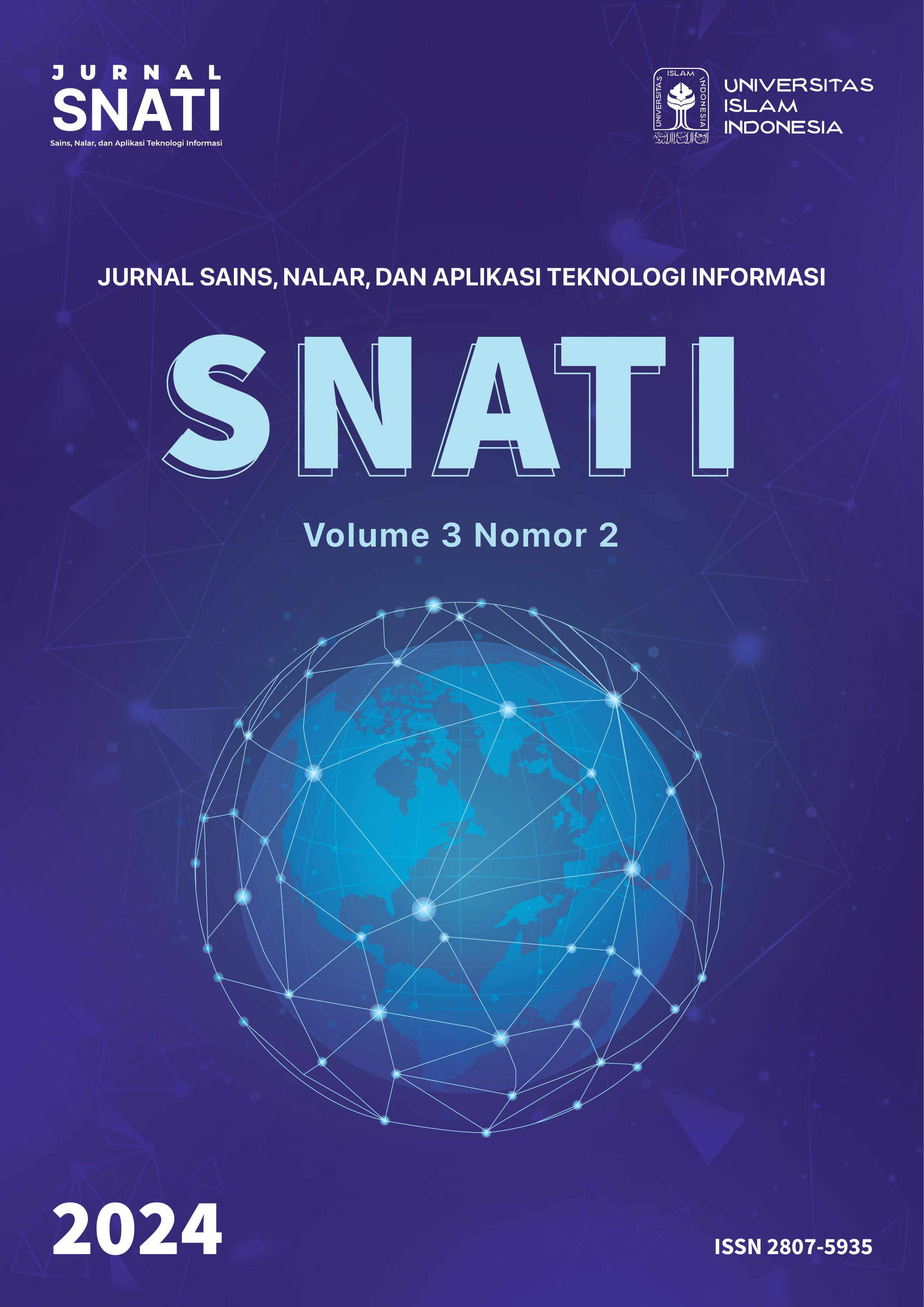Main Article Content
Abstract
This study focuses on applying the Apriori algorithm to course grades of 150 students. The research aims to uncover correlations between course grades, providing insights for both the researcher and the institution. Data was directly extracted from the student academic database. The Apriori algorithm was implemented in three scenarios with varying minimum support and confidence thresholds. The final results depict patterns in course grades that tend to co-occur. Among the three scenarios, the combination of Game Development with an A grade, Informatics Fundamentals with an A grade, and Advanced Math with an A grade yielded the highest values, with a support of 26% and confidence of 88.6%.
Keywords
Article Details
Copyright (c) 2024 Ilma Khoiruzzidan, Lizda Iswari

This work is licensed under a Creative Commons Attribution-ShareAlike 4.0 International License.
References
- A. S. Puspaningrum, F. Firdaus, I. Ahmad, and H. Anggono, “Perancangan Alat Deteksi Kebocoran Gas Pada Perangkat Mobile Android Dengan Sensor Mq-2,” J. Teknol. dan Sist. Tertanam, vol. 1, no. 1, p. 1, 2020, doi: 10.33365/jtst.v1i1.714.
- Y. Yuliana, P. Paradise, and K. Kusrini, “Sistem Pakar Diagnosa Penyakit Ispa Menggunakan Metode Naive Bayes Classifier Berbasis Web,” CSRID (Computer Sci. Res. Its Dev. Journal), vol. 10, no. 3, p. 127, 2021, doi: 10.22303/csrid.10.3.2018.127-138.
- Z. Hu, “Application and Research of Association rules and Decision tree Combination Algorithm in Student Achievement Analysis [D],” Place Preserv. Qingdao Univ. Technol., 2017.
- B. Santosa, “Data mining teknik pemanfaatan data untuk keperluan bisnis,” Yogyakarta Graha Ilmu, vol. 978, no. 979, p. 756, 2007.
- Despitaria, H. Sujaini, and Tursina, “Analisis Asosiasi pada Transaksi Obat Menggunakan Data Mining dengan Algoritma A Priori,” J. Sist. Dan Teknol. Inf., vol. 1, no. 1, pp. 1–6, 2016.
- F. Nurchalifatun, “Penerapan Metode Asosiasi Data Mining Menggunakan Algoritma Apriori Untuk Mengetahui Kombinasi Antar Itemset Pada Pondok Kopi,” Data Min., 2017.
- M. Badrul, P. Studi, and S. Informasi, “Algoritma Asosiasi Dengan Algoritma Apriori Untuk Analisa Data Penjualan,” J. Pilar Nusa Mandiri, vol. XII, no. ALGORITMA ASOSIASI DENGAN ALGORITMA APRIORI UNTUK ANALISA DATA PENJUALAN, pp. 121–129, 2016.
- X. Wu and Y. Zeng, “Using Apriori Algorithm on Students’ Performance Data for Association Rules Mining,” vol. 322, no. Iserss, pp. 403–406, 2019, doi: 10.2991/iserss-19.2019.300.
- R. Agrawal and R. Srikant, “Mining sequential patterns,” in Proceedings of the eleventh international conference on data engineering, IEEE, 1995, pp. 3–14.
- A. Kurniawati, “Pemetaan Pola Hubungan Program Studi Dengan Algoritma Apriori – Studi Kasus Spmu Unnes,” Edu Komputika J., vol. 1, no. 1, pp. 51–58, 2014.
- A. N. Rahmi and Y. A. Mikola, “Implementasi Algoritma Apriori Untuk Menentukan Pola Pembelian Pada Customer (Studi Kasus : Toko Bakoel Sembako),” Inf. Syst. J., vol. 4, no. 1, pp. 14–19, 2021, [Online]. Available: https://jurnal.amikom.ac.id/index.php/infos/article/view/561
- N. Kumar, S. Jain, and K. Chauhan, “Knowledge discovery from data mining techniques,” Int. J. Eng. Res. Technol., vol. 7, no. 12, pp. 1–3, 2019.
References
A. S. Puspaningrum, F. Firdaus, I. Ahmad, and H. Anggono, “Perancangan Alat Deteksi Kebocoran Gas Pada Perangkat Mobile Android Dengan Sensor Mq-2,” J. Teknol. dan Sist. Tertanam, vol. 1, no. 1, p. 1, 2020, doi: 10.33365/jtst.v1i1.714.
Y. Yuliana, P. Paradise, and K. Kusrini, “Sistem Pakar Diagnosa Penyakit Ispa Menggunakan Metode Naive Bayes Classifier Berbasis Web,” CSRID (Computer Sci. Res. Its Dev. Journal), vol. 10, no. 3, p. 127, 2021, doi: 10.22303/csrid.10.3.2018.127-138.
Z. Hu, “Application and Research of Association rules and Decision tree Combination Algorithm in Student Achievement Analysis [D],” Place Preserv. Qingdao Univ. Technol., 2017.
B. Santosa, “Data mining teknik pemanfaatan data untuk keperluan bisnis,” Yogyakarta Graha Ilmu, vol. 978, no. 979, p. 756, 2007.
Despitaria, H. Sujaini, and Tursina, “Analisis Asosiasi pada Transaksi Obat Menggunakan Data Mining dengan Algoritma A Priori,” J. Sist. Dan Teknol. Inf., vol. 1, no. 1, pp. 1–6, 2016.
F. Nurchalifatun, “Penerapan Metode Asosiasi Data Mining Menggunakan Algoritma Apriori Untuk Mengetahui Kombinasi Antar Itemset Pada Pondok Kopi,” Data Min., 2017.
M. Badrul, P. Studi, and S. Informasi, “Algoritma Asosiasi Dengan Algoritma Apriori Untuk Analisa Data Penjualan,” J. Pilar Nusa Mandiri, vol. XII, no. ALGORITMA ASOSIASI DENGAN ALGORITMA APRIORI UNTUK ANALISA DATA PENJUALAN, pp. 121–129, 2016.
X. Wu and Y. Zeng, “Using Apriori Algorithm on Students’ Performance Data for Association Rules Mining,” vol. 322, no. Iserss, pp. 403–406, 2019, doi: 10.2991/iserss-19.2019.300.
R. Agrawal and R. Srikant, “Mining sequential patterns,” in Proceedings of the eleventh international conference on data engineering, IEEE, 1995, pp. 3–14.
A. Kurniawati, “Pemetaan Pola Hubungan Program Studi Dengan Algoritma Apriori – Studi Kasus Spmu Unnes,” Edu Komputika J., vol. 1, no. 1, pp. 51–58, 2014.
A. N. Rahmi and Y. A. Mikola, “Implementasi Algoritma Apriori Untuk Menentukan Pola Pembelian Pada Customer (Studi Kasus : Toko Bakoel Sembako),” Inf. Syst. J., vol. 4, no. 1, pp. 14–19, 2021, [Online]. Available: https://jurnal.amikom.ac.id/index.php/infos/article/view/561
N. Kumar, S. Jain, and K. Chauhan, “Knowledge discovery from data mining techniques,” Int. J. Eng. Res. Technol., vol. 7, no. 12, pp. 1–3, 2019.
